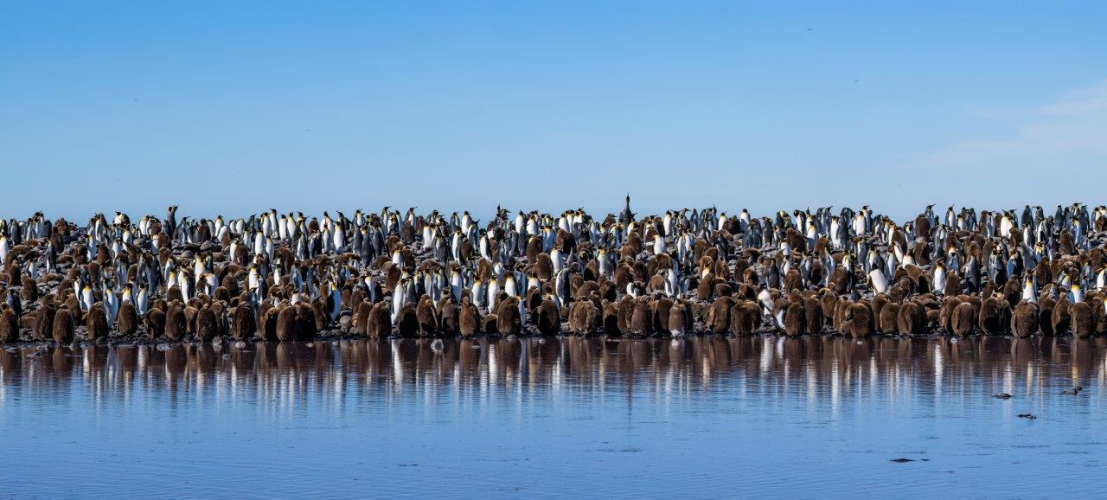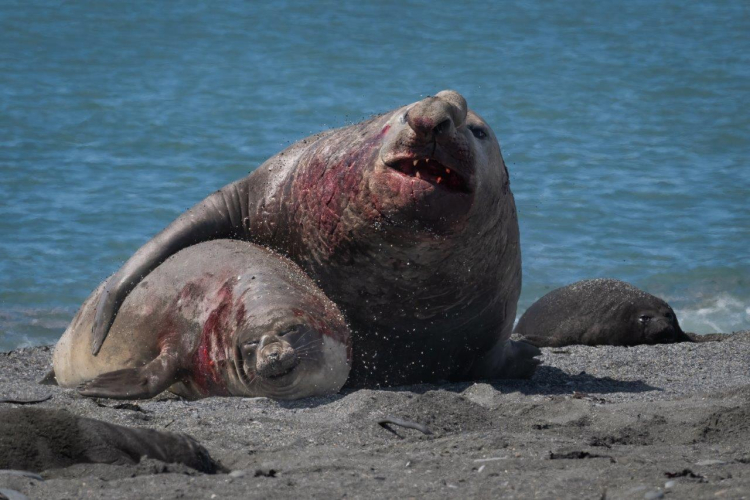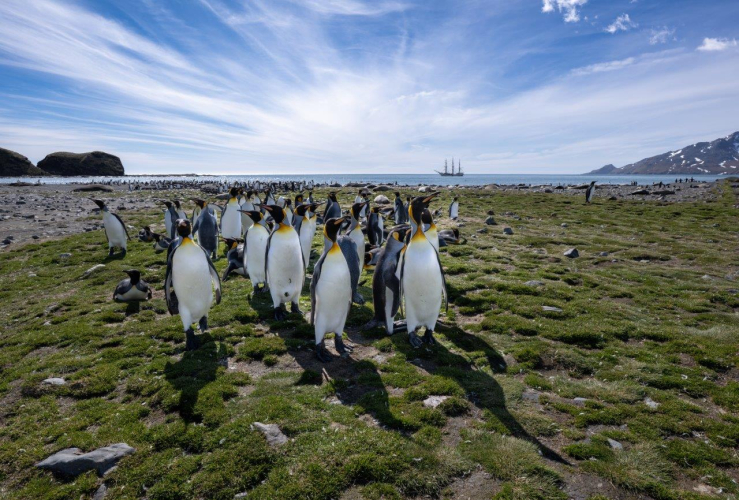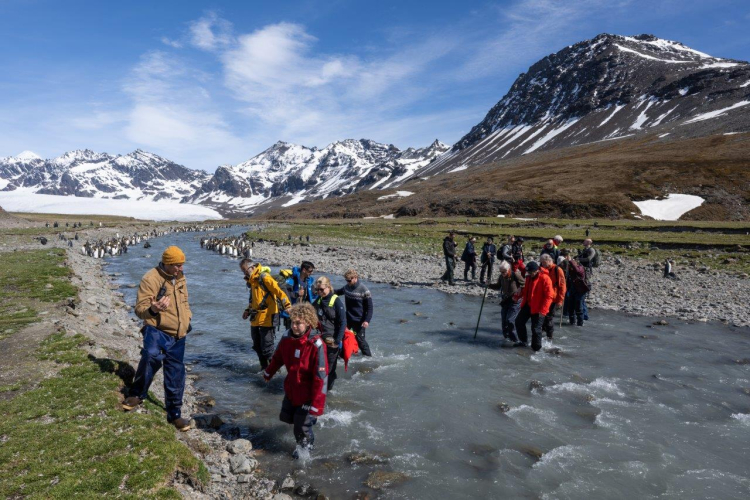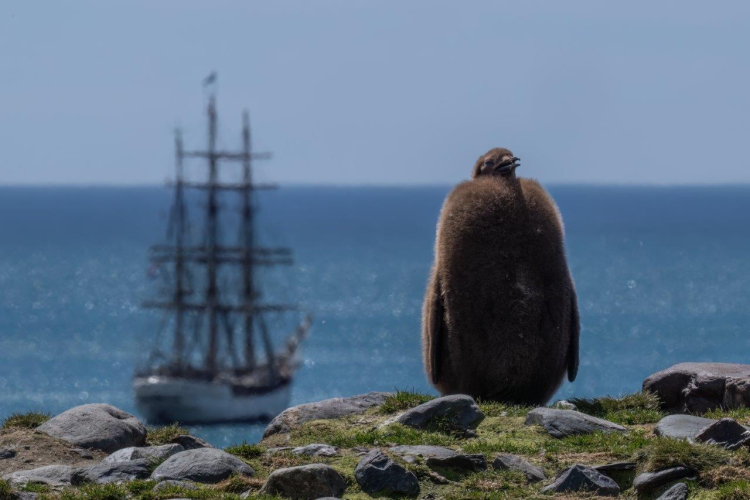South Georgia
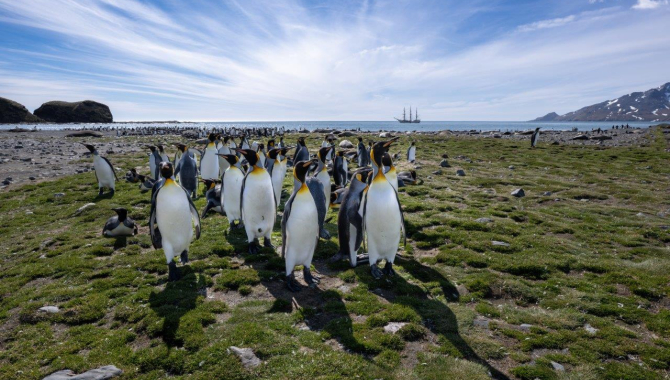
Morning landing at St. Andrews Bay. A visit in the afternoon to Brisbane Point in Royal Bay. A morning like not many others in South Georgia. The sun shines over the wide-open St. Andrews Bay. Just a bit of surge runs over the large open stretch of sandy beach, while in the backdrop clouds hang over the tops of Mount King, Vogel Peak, Smoky Wall, Mounts Patterson, and Skittle (all part of the large Allardyce Mountain Range).
The extensive outwash plains of Cook, Heaney, and Buxton Glaciers are home to the largest King penguin colony of the island, and probably in the world.
The flat and undulating moraine terrain is nowadays home to 160,000 to 200,000 pairs of King penguins, but it hasn’t always been like that. Their populations on the island are doing well and increasing. For instance, during the International Polar Year of 1882-83, scientists counted about 1,100 pairs. In 1925 the colony had grown to 32,000 pairs. Sixty years later their numbers had grown to 150,000 couples, and they continue to increase as the years pass.
But they are not on their own here. Countless Fur seals are starting to occupy the beach. Big powerful males are taking their small territories and some females are already arriving and giving birth. Amongst them stand a couple of rare light-colored ones: leucistic seals, a condition that results in the partial loss of pigmentation causing white, pale, or patchy coloration. But also, for the last few weeks, the real kings have been the massive Elephant seals. Still, a few of the breeding individuals remain scattered around. Some late harems with their beach-masters and a few females, now receptive to mate after giving birth in the last few days. The largest numbers of them are finished though, and now it is just the three-week to a month-old pups lying around everywhere. “Satellite" males keep trying their luck to sneak into one of the few harems around and get a female while the beach-master is busy fighting some other male or mating.
A place teeming with wildlife, where we are privileged to land and visit for a few hours. A walk over the high side of the beach leads up to a couple of stunning viewpoints over the whole of the main rookery. A short, easy hike not exempt from some excitement due to the wildlife encounters on the way and the crossing of a couple of meltwater streams. From up the hills, the view is breathtaking. Better to remain in silence for a while, overwhelmed by the sheer scale of the sight, both the King’s main nesting grounds and the whole of the surroundings.
We are fortunate today with the weather and sea conditions at St. Andrews, but often it is not the case. Well… even though the swell is low, this is always a “wet feet, stern-Zodiac landing,” both for disembarking and embarking the boats to return to the ship.
Next stop scheduled is Royal Bay. As usual, and as the trip is planned, we hop between landings a few more miles further south to the next spot to visit. A couple of hours motoring brought us to this ample embayment of about 6km from side to side, where a couple of glaciers debouch their ice to the sea and several coves open.
Royal Bay was already discovered and named by James Cook in 1775. And it is also well known for being the area where in 1882 a German group of the International Polar Year Investigations expedition under Schrader was stationed to observe the transit of Venus. The scientists came here on the steam corvette SMS Moltke, which was the first powered vessel to reach South Georgia. Moltke Harbour, a one-mile-wide bay on the northwest side of Royal Bay, is named after it. But our goal is a bit further south, at Brisbane Point.
The way here was windless and calm until reaching the bay itself, where strong winds and gusts blow straight from the Ross Glacier.
Passing the worst of it as we cross in front of the ice, Europa drops anchor close to the end moraine of the next glacier in the bay, the Weddell. With its land-terminating front in the background, as it receded it left a shallow reef that the Zodiacs will need to negotiate to reach the calm waters inside the little cove made by the headland of Brisbane Point. Still, the gusts climb to 25 to 30 knots, but the waters are quite flat, just waves breaking but no noticeable swell. So, conditions look just good enough to scout the landing site and as it went well, soon we embark the boats on an adventurous ride towards a secluded beach where it is easy to land. Here about 30,000 pairs of King penguins breed, using the swell to surf as they like at the exposed coastline open to the ample Royal Bay, but also with the sheltered and flat area where we put the Zodiacs ashore, left behind by the retreat of Weddell Glacier.
There’s not much of the afternoon left before the sun goes down the mountains and it is dinner time, but nevertheless, the sights of the colony and a walk around a bit amongst penguins and seals in this not-so-visited site and its splendid views is a real treat.
We come back on board with the idea of spending the night at anchor and making way towards the nearby Gold Harbour a bit before breakfast, but the ship pulls hard and drags already in the early hours of the morning. Time to heave and start slowly moving towards this next planned landing site.
